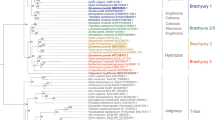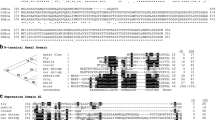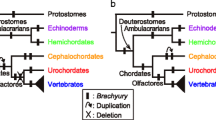Abstract
The expression patterns of Brachyury (Bra) orthologs in the development of four species of sand dollars (order: Clypeasteroida), including a direct-developing species, and of a sea urchin species (order: Echinoida) were investigated during the period from blastula to the pluteus stage, with special attention paid to the relationship between the expression pattern and the mode of gastrulation. The sand dollar species shared two expression domains of the Bra orthologs with the Echinoida species, in the vegetal ring (the first domain) and the oral ectoderm (the second domain). The following heterotopic changes in the expression of the Bra genes were found among the sand dollar species and between the sand dollars and the Echinoida species. (1) The vegetal ring expressing Bra in the sand dollars was much wider and was located at a higher position along the AV axis, compared with that in the Echinoida species. The characteristic Bra expression in the vegetal ring of the sand dollar embryos was thought to be involved in the mode of gastrulation, in which involution continues from the beginning of invagination until the end of gastrulation. (2) Two of the three indirect-developing sand dollar species that were examined exhibited a third domain, in which Bra was expressed on the oral side of the archenteron. (3) In the direct-developing sand dollar embryos, Bra was expressed with an oral-aboral asymmetry in the vegetal ring and with a left-right asymmetry in the oral ectoderm. In the Echinoida species, Bra was expressed in the vestibule at the six-armed pluteus stage.







Similar content being viewed by others
References
Arenas-Mena C, Cameron AR, Davidson EH (2000) Spatial expression of Hox cluster genes in the ontogeny of a sea urchin. Development 127:4631–4643
Arendt D, Technau U, Wittbrodt J (2001) Evolution of the bilaterian larval foregut. Nature 409:81–85
Croce J, Lhomond G, Gache C (2001) Expression pattern of Brachyury in the embryo of the sea urchin Paracentrotus lividus. Dev Genes Evol 211:617–619
Dan K, Okazaki K (1956) Cyto-embryological studies of sea urchin. III. Role of the secondary mesenchyme cells in the formation of the primitive gut in sea urchin larvae. Biol Bull 110:29–42
Durham JW (1966) Treatise on invertebrate paleontology, part U. Echinodermata 3. Geological Society of America and University of Kansas, Lawrence, Kan., pp 450–491
Emily-Fenouil F, Ghiglione C, Lhomond G, Lepage T, Gache C (1998) GSK3beta/shaggy mediates patterning along the animal-vegetal axis of the sea urchin embryo. Development 125:2489–2498
Ettensohn CA (1985) Gastrulation in the sea urchin embryo is accompanied by the rearrangement of invaginating epithelial cells. Dev Biol 112:383–390
Gross JM, McClay DR (2001) The role of Brachyury (T) during gastrulation movements in the sea urchin Lytechinus variegatus. Dev Biol 239:132–147
Gustafson T, Kinnander H (1956) Microaquaria for time-lapse cinematographic studies of morphogenesis in swimming larvae and observations on sea urchin gastrulation. Exp Cell Res 11:36–51
Harada Y, Yasuo H, Satoh N (1995) A sea urchin homologue of the chordate Brachyury (T) gene is expressed in the secondary mesenchyme founder cells. Development 121:2747–2754
Hardin JD, Cheng LY (1986) The mechanisms and mechanics of archenteron elongation during sea urchin gastrulation. Dev Biol 115:490–501
Herrmann BG, Kispert A (1994) The T genes in embryogenesis. Trends Genet 10:280–286
Hinman VF, Nguyen AT, Cameron RA, Davidson EH (2003) Developmental gene regulatory network architecture across 500 million years of echinoderm evolution. Proc Natl Acad Sci USA 100:13356–13361
Kispert A, Koschorz B, Herrmann BG (1995) The T protein encoded by Brachyury is a tissue-specific transcription factor. EMBO J 14:4763–4772
Kitazawa C, Kajihara Takai K, Nakajima Y, Fujisawa H, Amemiya S (2004) LiCl inhibits the establishment of left-right asymmetry in larvae of the direct-developing echinoid Peronella japonica. J Exp Zool 301A:707-717
Klein PS, Melton DA (1996) A molecular mechanism for the effect of lithium on development. Proc Natl Acad Sci USA 93:8455–8459
Kominami T, Masui M (1996) A cyto-embryological study of gastrulation in the sand dollar, Scaphechinus mirabilis. Dev Growth Differ 38:129–139
Kominami T, Takata H (2000) Cellular basis of gastrulation in the sand dollar Scaphechinus mirabilis. Biol Bull 199:287–297
Livingston BT, Wilt FH (1989) Lithium evokes expression of vegetal-specific molecules in the animal blastomeres of sea urchin embryos. Proc Natl Acad Sci USA 86:3669–3673
Logan CY, McClay DR (1997) The allocation of early blastomeres to the ectoderm and endoderm is variable in the sea urchin embryo. Development 124:2213–2223
Marcellini S, Technau U, Smith JC, Lemaire P (2003) Evolution of Brachyury proteins: identification of a novel regulatory domain conserved within Bilateria. Dev Biol 260:352–361
Mooi R (1990) Paedomorphosis, Aristotle’s lantern, and the origin of the sand dollars (Echinodermata: Clypeasteroida). Paleobiology 16:25–48
Mortensen T (1921) Studies of the development and larval forms of echinoderms. Gad, Copenhagen
Okazaki K, Dan K (1954) The metamorphosis of partial larvae of Peronella japonica Mortensen, a sand dollar. Biol Bull 106:83–99
Peterson KJ, Cameron RA, Tagawa K, Satoh N, Davidson EH (1999a) A comparative molecular approach to mesodermal patterning in basal deuterostomes: the expression pattern of Brachyury in the enteropneust hemichordate Ptychodera flava. Development 126:85–95
Peterson KJ, Harada Y, Cameron RA, Davidson EH (1999b) Expression pattern of Brachyury and Not in the sea urchin: comparative implications for the origins of mesoderm in the basal deuterostomes. Dev Biol 207:419–431
Peterson KJ, Cameron RA, Davidson EH (2000) Bilaterian origins: significance of new experimental observations. Dev Biol 219:1–17
Ransick A, Davidson EH (1998) Late specification of Veg1 lineages to endodermal fate in the sea urchin embryo. Dev Biol 195:38–48
Rast JP, Cameron RA, Poustka AJ, Davidson EH (2002) brachyury Target genes in the early sea urchin embryo isolated by differential macroarray screening. Dev Biol 246:191–208
Satoh N (2003) The ascidian tadpole larva: comparative molecular development and genomics. Nat Rev Genet 4:285–295
Satoh G, Harada Y, Satoh N (2000) The expression of nonchordate deuterostome Brachyury genes in the ascidian Ciona embryo can promote the differentiation of extra notochord cells. Mech Dev 96:155–163
Scholz CB, Technau U (2003) The ancestral role of Brachyury: expression of NemBra1 in the basal cnidarian Nematostella vectensis (Anthozoa). Dev Genes Evol 212:563–570
Shoguchi E, Satoh N, Maruyama YK (1999) Pattern of Brachyury gene expression in starfish embryos resembles that of hemichordate embryos but not of sea urchin embryos. Mech Dev 82:185–189
Tagawa K, Humphreys T, Satoh N (1998) Novel pattern of Brachyury gene expression in hemichordate embryos. Mech Dev 75:139–143
Takahashi H, Hotta K, Erives A, Di Gregorio A, Zeller RW, Levine M, Satoh N (1999) Brachyury downstream notochord differentiation in the ascidian embryo. Genes Dev 13:1519–1523
Takata H, Kominami T (2001) Ectoderm exerts the driving force for gastrulation in the sand dollar Scaphechinus mirabilis. Dev Growth Differ 43:265–274
Technau U (2001) Brachyury, the blastopore and the evolution of the mesoderm. Bioessays 23:788–794
Wada S, Katsuyama Y, Yasugi S, Saiga H (1995) Spatially and temporally regulated expression of the LIM class homeobox gene Hrlim suggests multiple distinct functions in development of the ascidian, Halocynthia roretzi. Mech Dev 51:115–126
Yasuo H, Satoh N (1998) Conservation of the developmental role of Brachyury in notochord formation in a urochordate, the ascidian Halocynthia roretzi. Dev Biol 200:158–170
Acknowledgements
We thank Dr. Masaaki Yamaguchi for providing the cDNA library and for his critical reading of the manuscript. We also thank Dr. Koji Akasaka for supplying the Brachyury cDNA. We are grateful to Dr. Mariko Kondo and Dr. Atsuo Nishino for helpful comments and continuous encouragement. We also wish to thank the staffs of the Misaki Marine Biological Station and the Asamushi Biological Station for their support in providing us with animals.
Author information
Authors and Affiliations
Corresponding author
Additional information
Edited by N. Satoh
Rights and permissions
About this article
Cite this article
Hibino, T., Harada, Y., Minokawa, T. et al. Molecular heterotopy in the expression of Brachyury orthologs in order Clypeasteroida (irregular sea urchins) and order Echinoida (regular sea urchins). Dev Genes Evol 214, 546–558 (2004). https://doi.org/10.1007/s00427-004-0437-x
Received:
Accepted:
Published:
Issue Date:
DOI: https://doi.org/10.1007/s00427-004-0437-x




